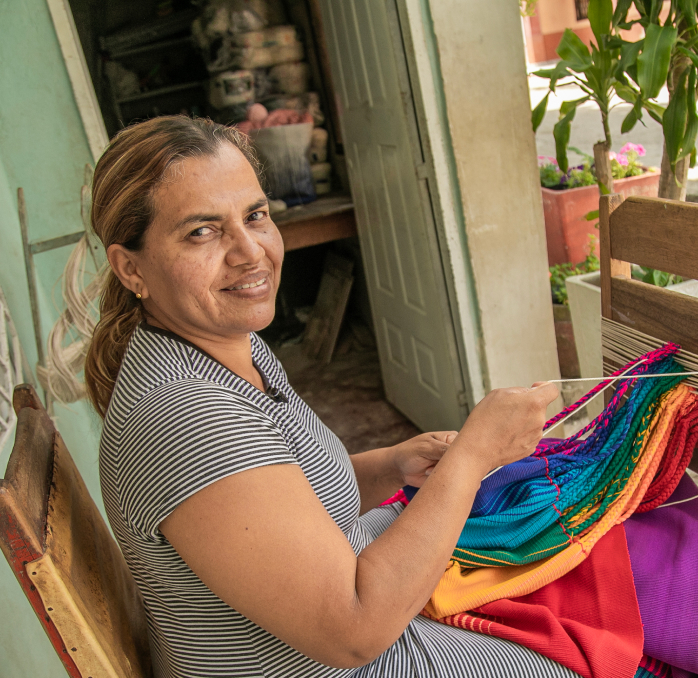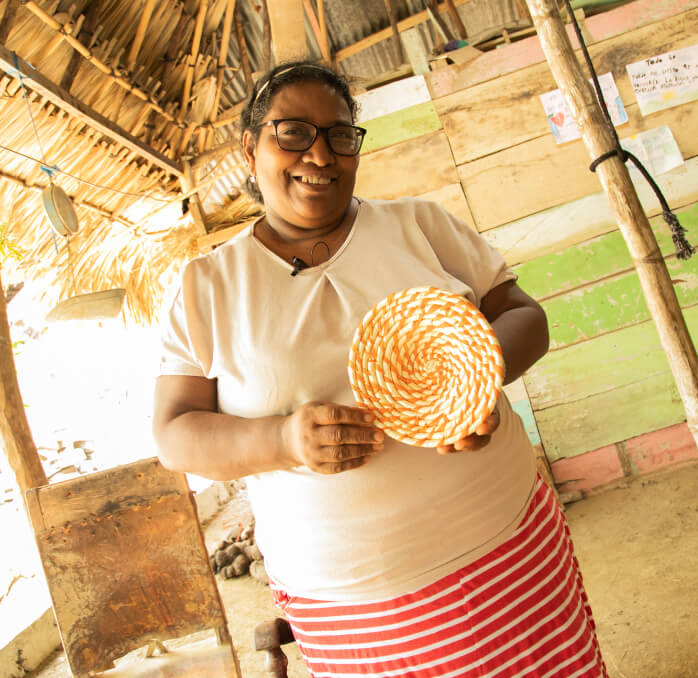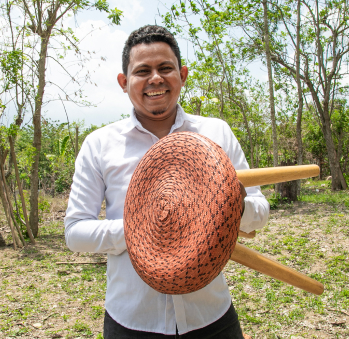Minelva Corena
Workshop: Artesanías Nelcy
Craft: Tejeduría
Trail: Sucre Route
Location: Morroa, Sucre
Minelva Corena fondly recalls her mother and grandmother as indefatigable women, preserving their teachings and expressions. In her childhood, her mother, the esteemed artisan Nelcy Pérez de Corena, imparted the art of weaving to her. Though the precise moment eludes her memory, she is aware that it all started at the age of five, as she wound the threads. At ten, and this she does remember, her grandmother, Victoria López, instructed her in the skill every child in Morroa must master: employing a small loom to weave bag straps. During this time, Minelva lived with her grandmother, laboring side by side. If unfinished by sunset, Victoria would take over, ensuring the strap’s completion, which would be exchanged for coffee the next morning. At eleven, recognizing her prowess, her grandmother proclaimed, “”this child is ready for the hammock.”” Thus, Minelva, a standout pupil, graduated from a 15cm loom to the 2mt vertical loom designated for crafting traditional hammocks. Morroa is renowned for its artisanship in hammock production, distinct from those made in San Jacinto or La Guajira.
As the 2000s dawned, Morroa was hit by the conflict that erupted in the Montes de María region. Minelva refers to it as an ideological clash; while the sounds of helicopters and distant explosions could be heard, armed individuals were never witnessed walking Morroa’s streets. Her father, named Blas after the town’s patron saint, confined her and her siblings to their home after six o’clock due to the imminent danger facing the youth. The war was a force invisible as thought that condemned her town to seclusion. Buyers of woven goods ceased passing by and artisans grew reliant on intermediaries.
Amidst this adversity, numerous men, displaced by violence and now residing in Morroa, learned the crafts of weaving and embroidery. Until then it had been a woman’s art, as crafting by men was associated with homosexuality. Nevertheless, they overcame the taboo. In this climate of necessity, Minelva experienced what she terms “”the spark.”” She conceived the idea of incorporating macramé knots into the hammock’s hanging threads. Recognizing hammocks’ potential as not just utilitarian items but also decorative pieces, she introduced novel elements and hues. She even shared the macramé technique with her mother, much like how she had collaborated with her grandmother earlier. Thus, nurturing tradition and enhancing its prominence became her means of expressing gratitude to the women who had raised her and imparted their teachings.
In the present, the tireless spirit of her mother and grandmother lives within Minelva. In her workshop, named Nelcy after her mother, her four vertical looms are used since sunrise. Those workers arriving late must toil in the afternoon heat, she chuckles as she recounts. Here, she winds threads into balls and secures 1,050 threads vertically onto the loom. Her skilled hands use the tapestry beater for weaving hammocks that possess a distinct, more airy quality compared to the tightly-woven counterparts of San Jacinto and La Guajira.
Among her seven siblings, Minelva and her brother, Blas José Corena, followed their mother’s counsel: to master the craft and safeguard the tradition. Blas employs embroidery to illustrate all kinds of designs on the hammocks—ranging from horses to soccer logos—while teaching his technique to others. Minelva, in turn, taught her own children the art of weaving, upholding their ancestral legacy through their craftsmanship. Her grandmother, who wove until a year before her passing at the age of 103, and her mother, who “could not write with a pencil but knew how to do it in the hammock”, are honored through their collective efforts.
Craft










Artisans along the way
Artisans along the way
No puede copiar contenido de esta página



























































